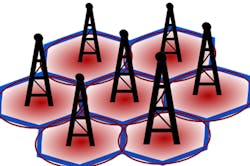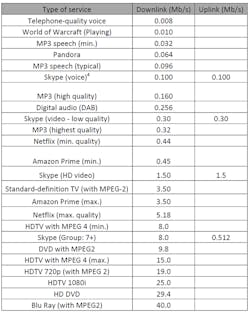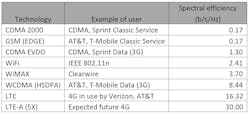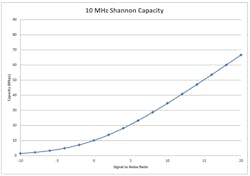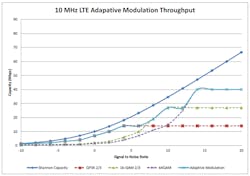Acquiring more users has been a goal of the cellular industry from the start. The push was to provide high-quality voice service to as much of a geographic area as possible, allowing cellular-communications operators to provide more service to more people. The industry has been quite successful, given that the number of licensed cell phones in the US exceeded the country’s population as of December 2011.1 Now, the cellular industry is undergoing a paradigm shift from providing basic voice service and text messages to supporting high-data-rate digital services. This push has significant repercussions for both the cellular infrastructure equipment and how that equipment is being designed, deployed, and managed.
In the last year, largely for the reasons discussed above, almost all of the major operators have been migrating at an unprecedented rate from their classic technology to newer cellular protocols. And more changes are already planned for the near future. Before detailing the specifics of these changes, it’s useful to understand the physics involved in driving them.
Ultimately, the most valuable assets owned by cellular companies around the world are licenses to specific blocks of RF spectrum. These licenses allow each company exclusive access to a particular set of radio frequencies for a specific geographic area to service cellular customers in that area. The cost of such licenses can be very significant. Some of the more recent Federal Communications Commission (FCC) actions in America cost the providers (and netted the US government) over $32.6 billion. These dollars (include Verizon’s Long-Term-Evolution (LTE) service in the newly created 700-MHz band by FCC auction 73,2 as well as the use of the AWS-1 band created by auction 663) by AT&T, Cricket, and Metro PCS.
To be competitive with other sources of data services, cellular providers must maximize the amount of data that can be pushed through the valuable spectrum that they have acquired. Figure 1 illustrates the data rates of many typical data services used by consumers for data connections. It also shows other “common” data rates that people encounter in their daily lives.
1. Shown are the data rates for various types of services.
The providers are interested in optimizing data rates for their customers. The bandwidth (the range of frequencies used for transmitting a signal) available to them is controlled by the licenses that they have purchased. Thus, the main objective of each cellular provider in the new paradigm is to get as much data (in bits per second) per unit of bandwidth possible. This is known as “spectral efficiency.” Figure 2 illustrates the spectral efficiency of a single tower using the current technologies available to cellular providers (along with some other common wireless protocols consumers may encounter for reference). Reviewing the data, it quickly becomes apparent why cellular providers have been adopting newer technology: It makes more efficient use of their most valuable assets—their spectrum licenses and bandwidths.
2. Here is the spectral efficiency of a single tower using the current technologies available to cellular providers.
Spectral efficiency does indeed indicate how efficiently the spectrum is used. For most of the data-focused protocols, though, the effective bandwidth is directly divided amongst the number of people sharing it. If we consider one block of a “typical” cellular license—for example, the PCS (1900-MHz) band A Block, which is 15-MHz wide—we can determine the effective bit rate available to the purchaser of that license using each technology.
The effect of multiple users using a Skype HD video call (which has a 1.5-Mb/s data-rate requirement) can be used as an example (Fig. 3). Here, it can easily be seen that even the most efficient protocol [LTE or Long Term Evolution-Advanced (LTE-A)] would be limited in how many customers can use it at once. The least-efficient protocol(s) would only be able to service one user with their entire license. As an important side note, some of these technologies require much more bandwidth. Thus, they could not actually be deployed in a single PCS-A Block License.
3. This graphic illustrates the number of HD-voice Skype calls in the PCS A-block license according to technology.
These issues introduce the need for reuse. In the early days of cellular networks, the general goal was to use the fewest number of towers possible to provide the customer-demanded level of service in the number of simultaneous voice calls. With data rates now the driving factor, there is a significant push to shrink the size of a given cell. As a result, fewer customers are using any one tower at a time and each has more available bandwidth. This geographic reuse effectively multiplies the number of users that can be supported and the amount of data service that can be provided. The improvements, however, come at the expense of more installations and more issues with interference and deployment that must be overcome. (This topic will be addressed much more thoroughly in my next article, which will focus on network design and deployment.)
Channel Quality Is Important Too
To best understand the technology, it is necessary to consider the effective signal-to-noise ratio (SNR) for a given mobile device when communicating with the tower. Previously, we were reviewing “theoretical” data rates from a tower under ideal conditions. In real-world use, though, the strength of the signal being received—relative to the other “unwanted” signals in the same spectrum—determines the effective data rates possible for a communications system.
This can be illustrated by a party in a crowded room, where many conversations are occurring at the same time. One can hear his or her neighbor talking “over the crowd” as long they are speaking loud enough to overcome the levels of the other conversations. However, if the crowd gets louder and the neighbor does not, one can no longer make out what the neighbor is saying. If the crowd gets quieter (or leaves), one can hear the neighbor at a much lower speaking level. Figure 4 shows the theoretical capacity of a 10-MHz bandwidth as a function of signal strength over its noise and interference.
4. The Shannon capacity of a 10-MHz bandwidth is displayed at varying signal-to-noise ratios.
Adaptive Modulation
Real-world protocols will never achieve these ideal rates. Yet they are nonetheless designed to take advantage of this physical benefit and use more advanced modulation types to achieve higher data rates in quieter channels. Here, they use a technique called adaptive modulation. For the technology employed with newer protocols, this means that if the spectrum can be very well managed and kept clear of unwanted interference, users on that channel can use a higher-throughput modulation type. In addition, each user can receive more effective data rates using the same amount of available spectrum. Figure 5 illustrates the effective data rate of LTE—for example, based on the SNR present in the communication channel with the theoretical maximum Shannon capacity overlaid.
5. Here is the effective throughput of LTE based on the signal-to-noise ratio.
When the SNR is low, this chart shows that an LTE network will use quadrature phase-shift keying (QPSK, which is essentially the same as 4QAM) to modulate its information to the user. As the SNR exceeds 7 dB, 16QAM (which has 2 times the throughput of QPSK) is a better choice for increased throughput. At an SNR of around 13 dB, the best modulation to use for throughput becomes 64QAM (which has 2 times the throughput of 16QAM and 4 times the throughput of QPSK).
This graph also shows why the network doesn’t always use more advanced modulation. At poorer (lower) SNRs, the error rate becomes high enough to where the actual throughput drops or higher-bit-count error codes must be used. This limits the effective payload. The “adaptive modulation” line shows that an LTE network adjusts to provide the maximum sustainable throughput based on the network’s channel condition.
Power Utilization
A review of the advantages of newer technology wouldn’t be complete without delving into its effects on user’s equipment. The most applicable, of course, is the standby and run time of a typical mobile handset. The desire to make ever-smaller cellular phones that are more capable is severely restricted by the power available from a typical phone’s battery.
To maximize useful battery life, each new cellular technology aims to minimize the power needed by a mobile phone—especially when not in use, in an operating condition known as “idle mode.” All of the throughput in the world won’t be useful if a cellular phone can only be connected for an hour or two for high-use consumers. In addition to conserving power when a person isn’t using their phone at all, most techniques for optimizing power usage allow the equipment’s radio to sleep when the tower is communicating with other users.
Beyond optimizing how long the transmitter is on, it is important to consider the pure physics of minimizing how much power the phone must use when it is transmitting. Newer technologies try to make the best use of their “reverse” (or mobile-to-tower) link power by adopting power- and channel-efficient modulation schemes. Finally, the farther the tower is from the mobile device, the more power it must use (resulting in shorter battery life) for the signal to reach the tower and be decoded (heard). This aspect favors more densely located towers as well as high-gain antennas, which enable the user device’s signal to bridge the gap between it and the base station while using as little energy as practical. This approach also helps to lower the interference that a mobile device might cause to another user in the area, improving the overall SNR while enabling higher effective data rates.
Answering The Voice Question
With all of these points taken into account, it is easy to foresee that cellular providers will begin phasing out their legacy technologies in favor of the more efficient technology provided by LTE. The last hurdle to overcome is providing for voice calls over the LTE network. There are multiple competing methods, including overlay services like Skype. But the protocol likely to be adopted by cellular providers is known as Voice over LTE (VoLTE). By 2015, VoLTE is expected to be the deployed standard for voice communication on LTE networks.5 Once the capability exists in LTE and LTE-A to support legacy services (as they have in the past, moving from AMPS to IS-136 and then to either CDMA or GSM), cellular providers will most likely turn off their older technologies to get more revenue from their existing licenses and spectrum.
References:
1. http://www.ctia.org/consumer_info/index.cfm/AID/10323
2. http://wireless.fcc.gov/auctions/default.htm?job=auction_summary&id=73
3. http://wireless.fcc.gov/auctions/default.htm?job=auction_summary&id=66
4. https://support.skype.com/en-us/faq/FA1417/how-much-bandwidth-does-skype-need
5. http://money.cnn.com/2012/09/13/technology/iphone-5-4g/index.html?eref=mrss_igoogle_business
About the Author
Tom Callahan
General Manager and CTO
Tom Callahan is the General Manager and CTO of QRC Technologies, a provider of network-discovery cellular test and measurement tools for military and government use. Prior to establishing QRC Technologies, Callahan was Vice President of Engineering for PCTEL’s RF Solutions group, which focused on building cellular scanning receivers. He previously worked as a DSP Engineer building signal-intercept systems for Watkins–Johnson. Callahan has a BSEE and MBA. He is an expert in the air interfaces for cellular protocols and has worked in numerous roles including as a DSP, software, and systems engineer. Callahan also is a Certified Program Management Professional (PMP).
